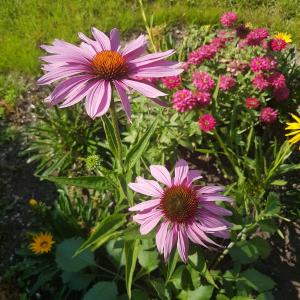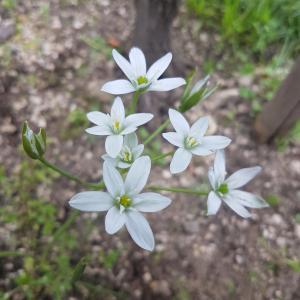
Geraniums are a diverse and widely loved group of flowering plants that are popular in gardens, landscapes, and containers around the world. Here's an in-depth look at geraniums, covering their history, types, care, and more:
Overview and History
Scientific Classification:
Kingdom: Plantae
Family: Geraniaceae
Genus: Geranium and Pelargonium
The term "geranium" often refers to plants from two different genera: Geranium and Pelargonium. True geraniums, also known as "hardy geraniums" or "cranesbills," are perennial plants that are native to temperate regions. On the other hand, what are commonly referred to as "geraniums" in gardening (especially in the U.S. and U.K.) are actually from the genus Pelargonium. This misnomer dates back to when these plants were first brought to Europe from South Africa in the 17th century and were mistakenly classified together.
Types of Geraniums
Hardy Geraniums (True Geraniums)
Characteristics: Hardy geraniums are perennial plants that can survive cold winters and return year after year. They have rounded, deeply lobed leaves, and their flowers are typically small and delicate, with colors ranging from white to purple and pink.
Popular Varieties:
Geranium sanguineum (Bloody Cranesbill)
Geranium macrorrhizum (Bigroot Geranium)
Geranium pratense (Meadow Cranesbill)
Pelargoniums (Common Geraniums)
Characteristics: Pelargoniums are more commonly grown as annuals in colder climates, although they are perennial in warm regions. They are recognized by their irregular flower shapes, often with two upper petals that are different from the three lower petals. The leaves are often aromatic, and the flowers can be found in a vast array of colors including red, pink, white, and bi-colored.
Popular Varieties:
Pelargonium zonale (Zonal Geraniums): Characterized by their rounded leaves with a dark band or "zone." These are the most common garden geraniums.
Pelargonium peltatum (Ivy-leaved Geraniums): These have trailing growth habits, making them ideal for hanging baskets.
Pelargonium graveolens (Scented-leaved Geraniums): Known for their fragrant leaves, which can smell like rose, lemon, mint, or other scents.
Pelargonium x hortorum (Garden or Bedding Geraniums): These are hybrids that are commonly used in bedding displays.
Cultivation and Care
Light Requirements: Geraniums thrive in full sun to partial shade. For the best flowering, at least 6 hours of sunlight is ideal.
Soil: They prefer well-drained soil with moderate fertility. Hardy geraniums can tolerate poorer soils, while Pelargoniums prefer richer, slightly acidic to neutral soils.
Watering: Geraniums are relatively drought-tolerant once established, but regular watering will keep them looking their best. Overwatering can lead to root rot, especially in Pelargoniums.
Fertilization: Use a balanced, water-soluble fertilizer every 4-6 weeks during the growing season. Too much nitrogen can lead to lush foliage at the expense of flowers.
Pruning and Deadheading: Regular deadheading (removing spent flowers) encourages more blooms. Pruning leggy plants back by about a third can also stimulate new growth.
Propagation: Geraniums can be easily propagated by cuttings. Cut a healthy stem about 4-6 inches long, remove the lower leaves, and place it in water or directly in a well-draining potting mix until roots develop.
Common Problems and Pests
Pests: Geraniums are generally resistant to pests, but they can occasionally suffer from aphids, spider mites, whiteflies, and caterpillars. Regular inspection and treatment with insecticidal soap or neem oil can help control these issues.
Diseases: Root rot, caused by overwatering, is a common problem. Fungal diseases like botrytis blight can also occur, especially in humid conditions. Ensure good air circulation around the plants and avoid wetting the foliage.
Yellowing Leaves: This can be a sign of overwatering, poor drainage, or a lack of nutrients. Adjusting care practices usually solves the problem.
Uses and Benefits
Ornamental Use: Geraniums are widely used in gardens, as bedding plants, in containers, and as hanging baskets. Their vibrant flowers and attractive foliage make them a favorite for adding color to landscapes.
Herbal Use: Scented-leaved geraniums (Pelargonium graveolens) are used in aromatherapy and as a source of geranium oil, which is believed to have antiseptic and anti-inflammatory properties. The leaves can also be used to flavor foods or as an ingredient in potpourri.
Cultural Significance: Geraniums have been symbolic in various cultures. In Victorian times, they were often used in the language of flowers, where different types of geraniums conveyed different messages. For example, a red geranium might symbolize comfort, while a white one could signify innocence.
Seasonal Care
Winter Care: In cold climates, Pelargoniums should be brought indoors before the first frost. They can be overwintered as houseplants in a sunny window, or cut back and stored in a cool, dark place. Hardy geraniums generally survive winter without special care, though a layer of mulch can help protect the roots in extremely cold areas.
Spring and Summer Care: As the weather warms, gradually reintroduce overwintered geraniums to outdoor conditions. Begin regular watering and fertilization as new growth appears.
Companion Planting
Geraniums are excellent companion plants due to their ability to repel certain insects. They pair well with roses, tomatoes, and other garden plants that may be susceptible to pests. Their vibrant colors can also be used to complement other flowering plants in the garden.
Interesting Facts
Pelargonium vs. Geranium: The primary difference between the two genera lies in their floral symmetry. Geraniums have radially symmetrical flowers, while Pelargoniums have bilaterally symmetrical flowers.
Geranium Oil: The essential oil extracted from Pelargonium graveolens is widely used in perfumes, cosmetics, and aromatherapy. It has a rose-like scent and is believed to have various therapeutic properties, including stress relief and skin care benefits.
Conclusion
Geraniums, whether from the genus Geranium or Pelargonium, are versatile and beloved plants that bring color, fragrance, and beauty to gardens and homes. With proper care, they can thrive in a variety of conditions, making them a favorite choice for gardeners of all levels.
Avilable photo size for
Pelargonium Peltatum - free photos
- width: 3024 px
- height: 4032 px




















